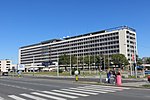Belgrade Stock Exchange
1894 establishments in SerbiaBuildings and structures in BelgradeBusiness organizations based in SerbiaEconomy of BelgradeInstances of Lang-sr using second unnamed parameter ... and 2 more
Organizations established in 1894Stock exchanges in Europe

The Belgrade Stock Exchange (abbr. BELEX, Serbian: Београдска берза, romanized: Beogradska berza) is a stock exchange based in Belgrade, Serbia. The Stock exchange was founded in 1894 in the Kingdom of Serbia, after the King proclaimed the Stock exchange law of 1886. Currently, the Belgrade Stock Exchange is a full member of Federation of Euro-Asian Stock Exchanges (FEAS) and an associate member of Federation of European Securities Exchanges (FESE).
Excerpt from the Wikipedia article Belgrade Stock Exchange (License: CC BY-SA 3.0, Authors, Images).Belgrade Stock Exchange
Omladinskih brigada, Belgrade New Belgrade (New Belgrade Urban Municipality)
Geographical coordinates (GPS) Address Nearby Places Show on map
Geographical coordinates (GPS)
| Latitude | Longitude |
|---|---|
| N 44.821944444444 ° | E 20.413055555556 ° |
Address
СИВ 3
Omladinskih brigada 1
11000 Belgrade, New Belgrade (New Belgrade Urban Municipality)
Central Serbia, Serbia
Open on Google Maps









